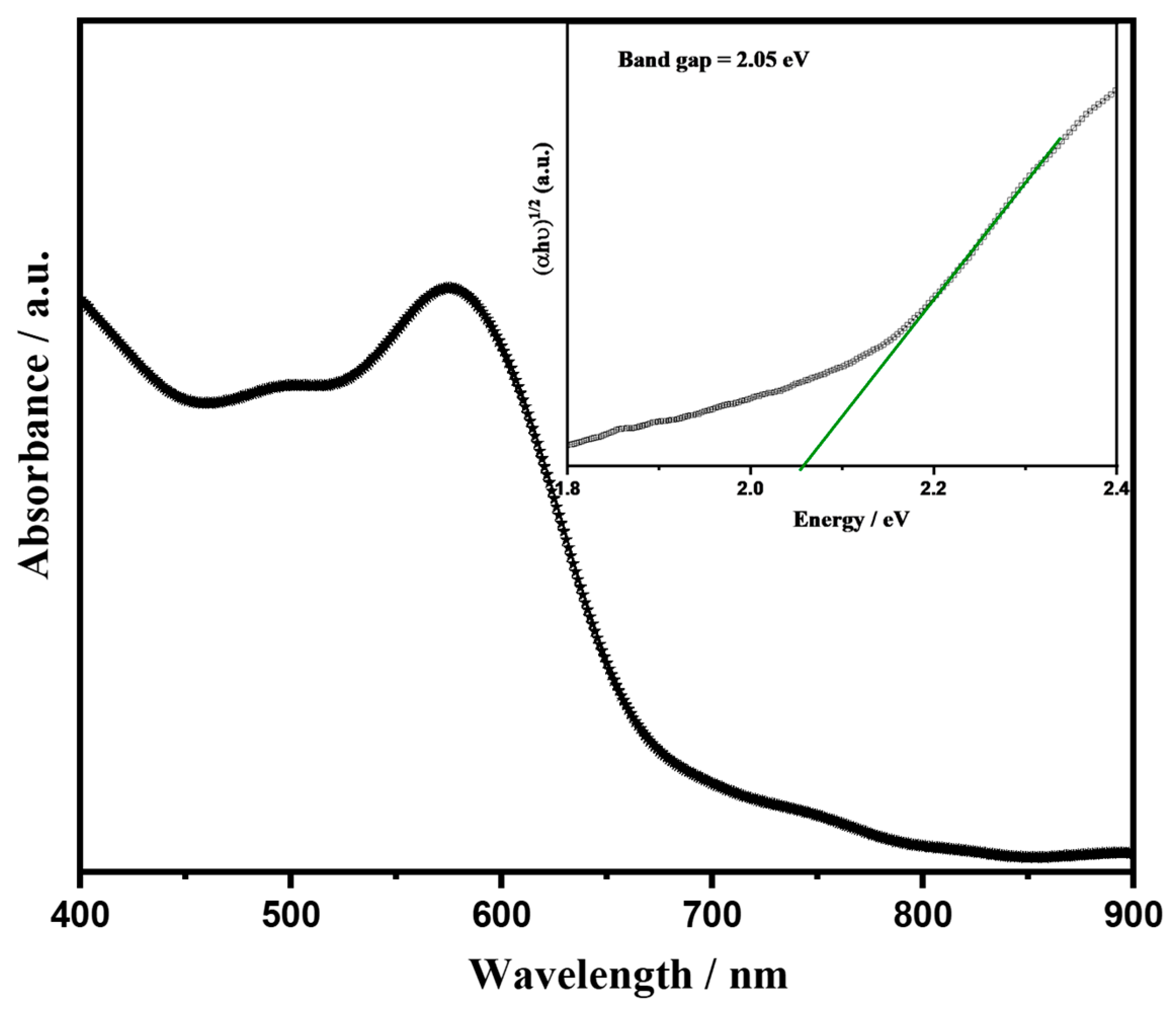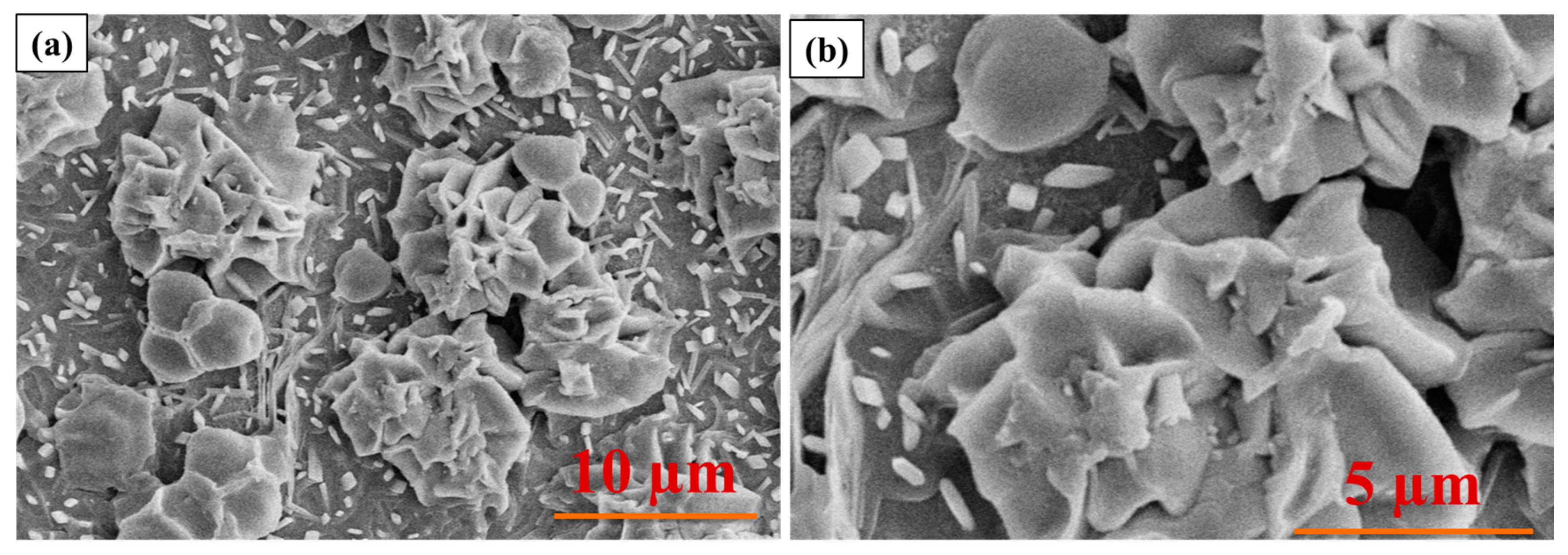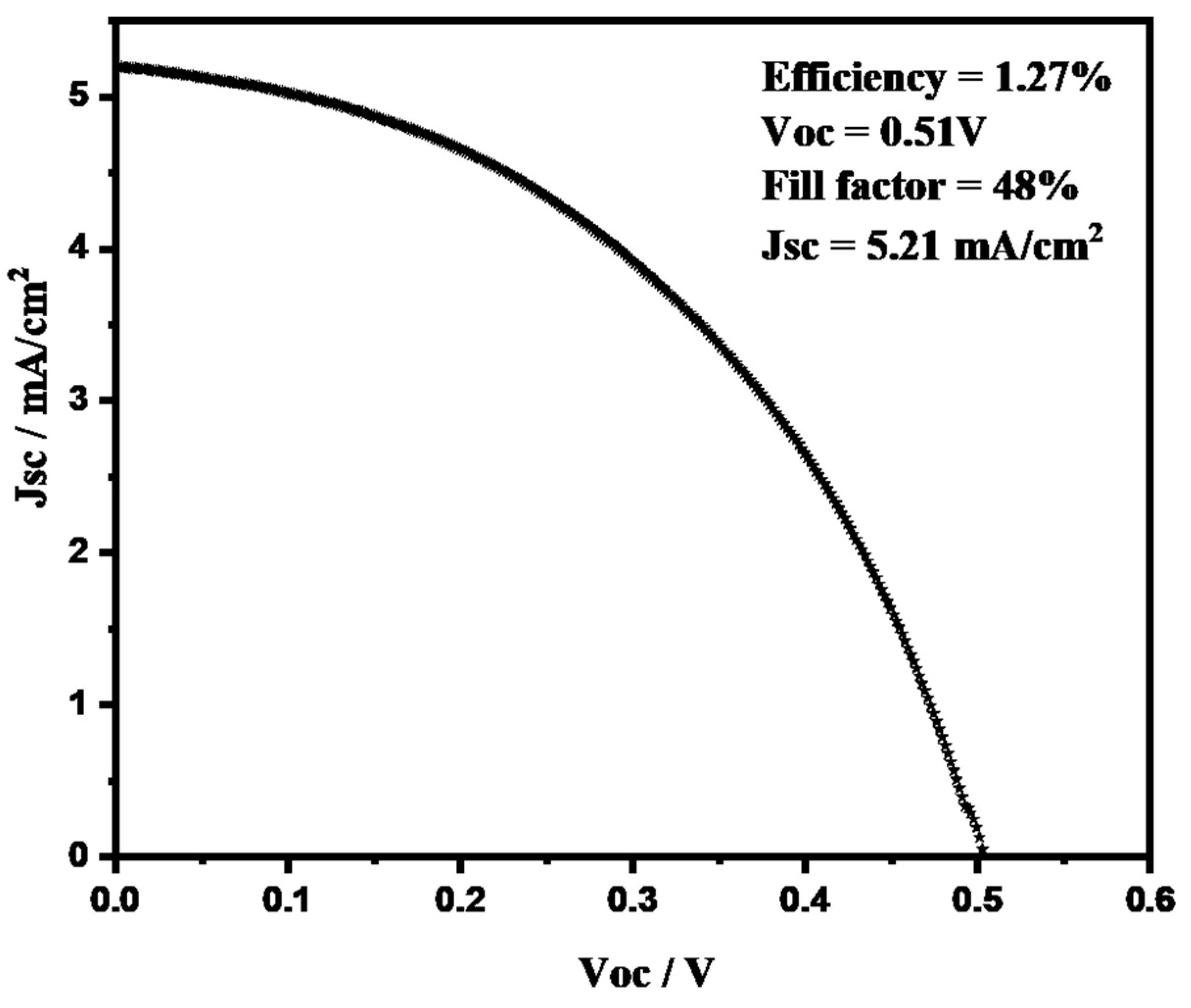Theoretical and Experimental Study of Methyl Ammonium Antimony Iodide-Based Lead-Free Perovskite Solar Cells
Abstract
:1. Introduction
2. Experimental Section
2.1. Simulation of PSCs
2.2. Chemicals
2.3. Fabrication of PSCs
3. Results and Discussion
3.1. Numerical Investigations
3.2. Performance Evaluation of Fabricated MA3Sb2I9-Based PSCs
4. Conclusions
Supplementary Materials
Author Contributions
Funding
Data Availability Statement
Acknowledgments
Conflicts of Interest
References
- Kojima, A.; Teshima, K.; Shirai, Y.; Miyasaka, T. Organometal Halide Perovskites as Visible-Light Sensitizers for Photovoltaic Cells. J. Am. Chem. Soc. 2009, 131, 6050–6051. [Google Scholar] [CrossRef]
- Ahmad, K.; Kumar, P.; Mobin, S.M. Hydrothermally grown novel pyramids of the CaTiO3 perovskite as an efficient electrode modifier for sensing applications. Mater. Adv. 2020, 1, 2003–2009. [Google Scholar] [CrossRef]
- Burgelman, M.; Nollet, P.; Degrave, S. Modelling polycrystalline semiconductor solar cells. Thin Solid Film. 2000, 361, 527–532. [Google Scholar] [CrossRef]
- Ahmad, K.; Shinde, M.A.; Kim, H. Molybdenum disulfide/reduced graphene oxide: Progress in synthesis and electro-catalytic properties for electrochemical sensing and dye sensitized solar cells. Microchem. J. 2021, 169, 106583. [Google Scholar] [CrossRef]
- Jeong, J.; Kim, M.; Seo, J.; Lu, H.; Ahlawat, P.; Mishra, A.; Yang, Y.; Hope, M.A.; Eickemeyer, F.T.; Kim, M.; et al. Pseudo-halide anion engineering for α-FAPbI3 perovskite solar cells. Nature 2021, 592, 381–385. [Google Scholar] [CrossRef] [PubMed]
- Park, N.-G.; Grätzel, M.; Miyasaka, T.; Zhu, K.; Emery, K. Towards stable and commercially available perovskite solar cells. Nat. Energy 2016, 1, 16152. [Google Scholar] [CrossRef]
- Saliba, M.; Matsui, T.; Seo, J.-Y.; Domanski, K.; Correa-Baena, J.-P.; Nazeeruddin, M.K.; Zakeeruddin, S.M.; Tress, W.; Abate, A.; Hagfeldt, A.; et al. Cesium-containing triple cation perovskite solar cells: Improved stability, reproducibility and high efficiency. Energy Environ. Sci. 2016, 9, 1989–1997. [Google Scholar] [CrossRef] [Green Version]
- Ahmad, K.; Mobin, S.M. Graphene oxide based planar heterojunction perovskite solar cell under ambient condition. New J. Chem. 2017, 41, 14253–14258. [Google Scholar] [CrossRef]
- Ahmad, K.; Kim, H. Enhanced stability of MAPbI3 based perovskite solar cells. Mater. Lett. 2022, 318, 132187. [Google Scholar] [CrossRef]
- Im, J.-H.; Lee, C.-R.; Lee, J.-W.; Park, S.-W.; Park, N.-G. 6.5% efficient perovskite quantum-dot-sensitized solar cell. Nanoscale 2011, 3, 4088–4093. [Google Scholar] [CrossRef]
- Kim, H.-S.; Lee, C.-R.; Im, J.-H.; Lee, K.-B.; Moehl, T.; Marchioro, A.; Moon, S.-J.; Humphry-Baker, R.; Yum, J.-H.; Moser, J.E.; et al. Lead Iodide Perovskite Sensitized All-Solid-State Submicron Thin Film Mesoscopic Solar Cell with Efficiency Exceeding 9%. Sci. Rep. 2012, 2, 591. [Google Scholar] [CrossRef] [PubMed] [Green Version]
- Kabir, E.; Kumar, P.; Kumar, S.; Adelodun, A.A.; Kim, K.-H. Solar energy: Potential and future prospects. Renew. Sustain. Energy Rev. 2018, 82, 894–900. [Google Scholar] [CrossRef]
- Min, H.; Kim, M.; Lee, S.-U.; Kim, H.; Kim, G.; Choi, K.; Lee, J.H.; Seok, I.S. Efficient, stable solar cells by using inherent bandgap of α-phase formamidinium lead iodide. Science 2019, 366, 749–753. [Google Scholar] [CrossRef] [PubMed]
- Yang, S.; Liu, W.; Zuo, L.; Zhang, X.; Ye, T.; Chen, J.; Li, C.-Z.; Wu, G.; Chen, H. Thiocyanate assisted performance enhancement of formamidinium based planar perovskite solar cells through a single one-step solution process. J. Mater. Chem. A 2016, 4, 9430–9436. [Google Scholar] [CrossRef]
- Kumar, P.; Ahmad, K.; Dagar, J.; Unger, E.; Mobin, S.M. Two-Step Deposition Approach for Lead Free (NH4)3Sb2I9 Perovskite Solar Cells with Enhanced Open Circuit Voltage and Performance. ChemElectroChem 2021, 8, 3150–3154. [Google Scholar] [CrossRef]
- Ahmad, K.; Mobin, S.M. Organic–Inorganic Copper (II)-Based Perovskites: A Benign Approach toward Low-Toxicity and Water-Stable Light Absorbers for Photovoltaic Applications. Energy Technol. 2020, 8, 1901185. [Google Scholar] [CrossRef]
- Ahmad, K.; Ansari, S.N.; Natarajan, K.; Mobin, S.M. A (CH3NH3)3Bi2I9 perovskite Based on a Two-Step Deposition Method: Lead-Free, Highly Stable, and with Enhanced Photovoltaic Performance. ChemElectroChem 2019, 6, 1192–1198. [Google Scholar] [CrossRef]
- Ahmad, K.; Ansari, S.N.; Natarajan, K.; Mobin, S.M. Design and Synthesis of 1D-Polymeric Chain Based [(CH3NH3)3Bi2Cl9]n Perovskite: A New Light Absorber Material for Lead Free Perovskite Solar Cells. ACS Appl. Energy Mater. 2018, 1, 2405–2409. [Google Scholar] [CrossRef]
- Ahmad, K.; Kumar, P.; Mobin, S.M. A Two-Step Modified Sequential Deposition Method-based Pb-Free (CH3NH3)3Sb2I9 Perovskite with Improved Open Circuit Voltage and Performance. ChemElectroChem 2020, 7, 946–950. [Google Scholar] [CrossRef]
- Noel, N.K.; Stranks, S.D.; Abate, A.; Wehrenfennig, C.; Guarnera, S.; Haghighirad, A.-A.; Sadhanala, A.; Eperon, G.E.; Pathak, S.K.; Johnston, M.B.; et al. Lead-free organic–inorganic tin halide perovskites for photovoltaic applications. Energy Environ. Sci. 2014, 7, 3061–3068. [Google Scholar] [CrossRef]
- Lakhdar, N.; Hima, A. Electron transport material effect on performance of perovskite solar cells based on CH3NH3GeI3. Opt. Mater. 2020, 99, 109517. [Google Scholar] [CrossRef]
- Li, J.; Cao, H.-L.; Jiao, W.-B.; Wang, Q.; Wei, M.; Cantone, I.; Lü, J.; Abate, A. Biological impact of lead from halide perovskites reveals the risk of introducing a safe threshold. Nat. Commun. 2020, 11, 310. [Google Scholar] [CrossRef] [PubMed] [Green Version]
- Ahmad, K.; Kumar, P.; Mobin, S.M. Inorganic Pb-Free Perovskite Light Absorbers for Efficient Perovskite Solar Cells with Enhanced Performance. Chem. Asian J. 2020, 15, 2859–2863. [Google Scholar] [CrossRef] [PubMed]
- Ahmad, K.; Mobin, S.M. Recent Progress and Challenges in A3Sb2X9-Based Perovskite Solar Cells. ACS Omega 2020, 5, 28404–28412. [Google Scholar] [CrossRef] [PubMed]
- Khadka, D.B.; Shirai, Y.; Yanagida, M.; Miyano, K. Tailoring the film morphology and interface band offset of caesium bismuth iodide-based Pb-free perovskite solar cells. J. Mater. Chem. C 2019, 7, 8335–8343. [Google Scholar] [CrossRef]
- Kang, J.; Chen, S.; Hao, M.; Liu, J.; Al-Mamun, M.; Liu, P.; Wang, Y.; Yin, H.; Zhao, H. Alloying Sb into all inorganic lead-free CsBi3I10 for improving the crystal growth and photovoltaic performance. J. Mater. Chem. A 2022, 10, 19618–19625. [Google Scholar] [CrossRef]
- Kulkarni, A.; Jena, A.K.; Ikegami, M.; Miyasaka, T. Performance enhancement of AgBi2I7 solar cells by modulating a solvent-mediated adduct and tuning remnant BiI3 in one-step crystallization. Chem. Commun. 2019, 55, 4031–4034. [Google Scholar] [CrossRef]
- Pandian, M.G.M.; Khadka, D.B.; Shirai, Y.; Umedov, S.; Yanagida, M.; Subashchandran, S.; Grigorieva, A.; Miyano, K. Effect of solvent vapour annealing on bismuth triiodide film for photovoltaic applications and its optoelectronic properties. J. Mater. Chem. C 2020, 8, 12173–12180. [Google Scholar] [CrossRef]
- Kulkarni, A.; Singh, T.; Jena, A.K.; Pinpithak, P.; Ikegami, M.; Miyasaka, T. Vapor Annealing Controlled Crystal Growth and Photovoltaic Performance of Bismuth Triiodide Embedded in Mesostructured Configurations. ACS Appl. Mater. Interfaces 2018, 10, 9547–9554. [Google Scholar] [CrossRef]
- Alam, I.; Mollick, R.; Ashraf, A. Numerical simulation of Cs2AgBiBr6-based perovskite solar cell with ZnO nanorod and P3HT as the charge transport layers. Phys. B Condens. Matter 2021, 618, 413187. [Google Scholar] [CrossRef]
- Madan, J.; Shivani; Pandey, R.; Sharma, R. Device simulation of 17.3% efficient lead-free all-perovskite tandem solar cell. Sol. Energy 2020, 197, 212–222. [Google Scholar] [CrossRef]
- Ahmad, O.; Rashid, A.; Ahmed, M.W.; Nasir, M.F.; Qasim, I. Performance evaluation of Au/p-CdTe/Cs2TiI6/n-TiO2/ITO solar cell using SCAPS-1D. Opt. Mater. 2021, 117, 111105. [Google Scholar] [CrossRef]
- Ahmed, S.; Jannat, F.; Khan, A.K.; Alim, M.A. Numerical development of eco-friendly Cs2TiBr6 based perovskite solar cell with all-inorganic charge transport materials via SCAPS-1D. Optik 2020, 225, 165765. [Google Scholar] [CrossRef]
- Samanta, M.; Ahmed, S.I.; Chattopadhyay, K.K.; Bose, C. Role of various transport layer and electrode materials in enhancing performance of stable environment-friendly Cs2TiBr6 solar cell. Optik 2020, 217, 164805. [Google Scholar] [CrossRef]
- Nalianya, M.A.; Awino, C.; Barasa, H.; Odari, V.; Gaitho, F.; Omogo, B.; Mageto, M. Numerical study of lead free CsSn0.5Ge0.5I3 perovskite solar cell by SCAPS-1D. Optik 2021, 248, 168060. [Google Scholar] [CrossRef]
- Sachchidanand, G.V.; Kumar, A.; Sharma, P. Numerical simulation of novel lead-free Cs3Sb2Br9 absorber-based highly efficient perovskite solar cell. Opt. Mater. 2021, 122, 111715. [Google Scholar] [CrossRef]
- Raj, A.; Kumar, M.; Singh, P.K.; Singh, R.C.; Bherwani, H.; Gupta, A.; Anshul, A. A computational approach to investigate the suitable ETL for lead-free CsGeI3 based perovskite solar cell. Mater. Today Proc. 2021, 47, 1564–1569. [Google Scholar] [CrossRef]
- Ahmmed, S.; Karim, A.; Rahman, H.; Aktar, A.; Islam, R.; Islam, A.; Ismail, A.B.M. Performance analysis of lead-free CsBi3I10-based perovskite solar cell through the numerical calculation. Sol. Energy 2021, 226, 54–63. [Google Scholar] [CrossRef]
- Islam, T.; Jani, R.; Al Amin, S.M.; Sami, S.U.; Shorowordi, K.; Hossain, M.I.; Devgun, M.; Chowdhury, S.; Banerjee, S.; Ahmed, S. Numerical simulation studies of a fully inorganic Cs2AgBiBr6 perovskite solar device. Opt. Mater. 2020, 105, 109957. [Google Scholar] [CrossRef]
- Li, S.; Liu, P.; Pan, L.; Li, W.; Yang, S.-E.; Shi, Z.; Guo, H.; Xia, T.; Zhang, S.; Chen, Y. The investigation of inverted p-i-n planar perovskite solar cells based on FASnI3 films. Sol. Energy Mater. Sol. Cells 2019, 199, 75–82. [Google Scholar] [CrossRef]
- Dixit, H.; Punetha, D.; Pandey, S.K. Improvement in performance of lead free inverted perovskite solar cell by optimization of solar parameters. Optik 2018, 179, 969–976. [Google Scholar] [CrossRef]
- Park, B.-W.; Philippe, B.; Zhang, X.; Rensmo, H.; Boschloo, G.; Johansson, E.M.J. ChemInform Abstract: Bismuth Based Hybrid Perovskites A3Bi2I9 (A: Methylammonium or Cesium) for Solar Cell Application. ChemInform 2015, 27, 6806–6813. [Google Scholar] [CrossRef]
- Zhang, M.; Lyu, M.; Yun, J.-H.; Noori, M.; Zhou, X.; Cooling, N.A.; Wang, Q.; Yu, H.; Dastoor, P.C.; Wang, L. Low-temperature processed solar cells with formamidinium tin halide perovskite/fullerene heterojunctions. Nano Res. 2016, 9, 1570–1577. [Google Scholar] [CrossRef]
- Jung, M.-C.; Raga, S.R.; Qi, Y. Properties and solar cell applications of Pb-free perovskite films formed by vapor deposition. RSC Adv. 2016, 6, 2819–2825. [Google Scholar] [CrossRef]
- Yokoyama, T.; Song, T.-B.; Cao, D.H.; Stoumpos, C.C.; Aramaki, S.; Kanatzidis, M.G. The Origin of Lower Hole Carrier Concentration in Methylammonium Tin Halide Films Grown by a Vapor-Assisted Solution Process. ACS Energy Lett. 2016, 2, 22–28. [Google Scholar] [CrossRef]
- Liu, X.; Yang, Z.; Chueh, C.-C.; Rajagopal, A.; Williams, S.T.; Sun, Y.; Jen, A.K.-Y. Improved efficiency and stability of Pb–Sn binary perovskite solar cells by Cs substitution. J. Mater. Chem. A 2016, 4, 17939–17945. [Google Scholar] [CrossRef]
- Li, P.; Gao, W.; Ran, C.; Dong, H.; Hou, X.; Wu, Z. Post-treatment engineering of vacuum-deposited Cs2NaBiI6 double perovskite film for enhanced photovoltaic performance. Phys. Status Solidi A 2019, 216, 1900567–1900574. [Google Scholar] [CrossRef]
- Pantaler, M.; Cho, K.T.; Queloz, V.I.E.; García-Benito, I.; Fettkenhauer, C.; Anusca, I.; Nazeeruddin, M.K.; Lupascu, D.C.; Grancini, G. Hysteresis-Free Lead-Free Double-Perovskite Solar Cells by Interface Engineering. ACS Energy Lett. 2018, 3, 1781–1786. [Google Scholar] [CrossRef]
- Cui, X.-P.; Jiang, K.-J.; Huang, J.-H.; Zhang, Q.-Q.; Su, M.-J.; Yang, L.-M.; Song, Y.-L.; Zhou, X.-Q. Cupric bromide hybrid perovskite heterojunction solar cells. Synth. Met. 2015, 209, 247–250. [Google Scholar] [CrossRef]
- Ran, C.; Wu, Z.; Xi, J.; Yuan, F.; Dong, H.; Lei, T.; He, X.; Hou, X. Construction of Compact Methylammonium Bismuth Iodide Film Promoting Lead-Free Inverted Planar Heterojunction Organohalide Solar Cells with Open-Circuit Voltage over 0.8 V. J. Phys. Chem. Lett. 2017, 8, 394–400. [Google Scholar] [CrossRef]
- Johansson, M.B.; Zhu, H.; Johansson, E.M.J. Extended Photo-Conversion Spectrum in Low-Toxic Bismuth Halide Perovskite Solar Cells. J. Phys. Chem. Lett. 2016, 7, 3467–3471. [Google Scholar] [CrossRef] [PubMed]
- Hebig, J.-C.; Kühn, I.; Flohre, J.; Kirchartz, T. Optoelectronic properties of (CH3NH3)3Sb2I9 thin films for photovoltaic applications. ACS Energy Lett. 2016, 1, 309–314. [Google Scholar] [CrossRef]
- Harikesh, P.C.; Mulmudi, H.K.; Ghosh, B.; Goh, T.W.; Teng, Y.T.; Thirumal, K.; Lockrey, M.; Weber, K.; Koh, T.M.; Li, S.; et al. Rb as an Alternative Cation for Templating Inorganic Lead-Free Perovskites for Solution Processed Photovoltaics. Chem. Mater. 2016, 28, 7496–7504. [Google Scholar] [CrossRef]
- Zuo, C.; Ding, L. Lead-free perovskite materials (NH4)3Sb2IxBr 9–x. Angew. Chem. Int. Ed. 2017, 56, 6528–6532. [Google Scholar] [CrossRef] [PubMed]
- Baranwal, A.K.; Masutani, H.; Sugita, H.; Kanda, H.; Kanaya, S.; Shibayama, N.; Sanehira, Y.; Ikegami, M.; Numata, Y.; Yamada, K.; et al. Lead-free perovskite solar cells using Sb and Bi-based A3B2X9 and A3BX6 crystals with normal and inverse cell structures. Nano Converg. 2017, 4, 1–14. [Google Scholar] [CrossRef] [Green Version]
- Lyu, M.; Yun, J.-H.; Cai, M.; Jiao, Y.; Bernhardt, P.V.; Zhang, M.; Wang, Q.; Du, A.; Wang, H.; Liu, G.; et al. Organic–inorganic bismuth (III)-based material: A lead-free, air-stable and solution-processable light-absorber beyond organolead perovskites. Nano Res. 2016, 9, 692–702. [Google Scholar] [CrossRef]








| Material | Voc (V) | Jsc (mA/cm2) | F.F. (%) | PCE (%) | References |
|---|---|---|---|---|---|
| MA3Sb2I9 | 1.41 | 12.49 | 84 | 14.90 | Present study |
| CH3NH3GeI3 | 0.93 | 23.44 | 60.75 | 13.30 | [21] |
| Cs2AgBiBr6 | 0.91 | 11.11 | 47 | 4.48 | [30] |
| FACsPb0.5Sn0.5I3 | 0.69 | 14.8 | 71.92 | 7.36 | [31] |
| Cs2TiI6 | 1.39 | 25.08 | 43.17 | 15.06 | [32] |
| Cs2TiBr6 | 1.53 | 8.66 | 86.45 | 11.49 | [33] |
| Cs2TiBr6 | 1.12 | 10.25 | 73.6 | 8.5 | [34] |
| CsSn0.5Ge0.5I3 | 0.87 | 27.05 | 79.25 | 18.79 | [35] |
| Cs3Sb2Br9 | 1.31 | 13.67 | 86.78 | 15.69 | [36] |
| CsGeI3 | 0.64 | 20.64 | 63 | 8.45 | [37] |
| CsBi3I10 | 0.93 | 15.90 | 70.32 | 10.43 | [38] |
| Cs2AgBiBr6 | 1.50 | 11.45 | 42.14 | 7.25 | [39] |
| FASnI3 | 0.61 | 21.2 | 72.9 | 9.6 | [40] |
| FASnI3 | 0.62 | 20.55 | 77.97 | 9.90 | [41] |
| Material | Voc (V) | Jsc (mA/cm2) | F.F. (%) | PCE (%) | References |
|---|---|---|---|---|---|
| FASnI2Br | 0.44 | 2 | 53.3 | 0.47 | [43] |
| MASnBr3 | 0.41 | 2.05 | 41.1 | 0.35 | [44] |
| MASnBr3 | 0.30 | 1.22 | 36.8 | 0.14 | [45] |
| MA0.9Cs0.1SnI3 | 0.20 | 4.53 | 36.4 | 0.33 | [46] |
| Cs2NaBiI6 | 0.70 | 0.91 | 33 | 0.21 | [47] |
| Cs2AgBiBr6 | 0.64 | 2.45 | 57 | 0.90 | [48] |
| CH3(CH2)3NH3)2-CuBr4 | 0.88 | 1.78 | 40 | 0.63 | [49] |
| (CH3NH3)3Bi2I9 | 0.83 | 1.39 | 34 | 0.39 | [50] |
| Cs3Bi2I9 | 0.31 | 3.40 | 38 | 0.40 | [51] |
| (CH3NH3)3Sb2I9 | 0.89 | 1.15 | 55 | 0.55 | [52] |
| Rb3Sb2I9 | 0.55 | 2.11 | 56.9 | 0.65 | [53] |
| (NH4)3Sb2IxBr9–x | 1.03 | 1.15 | 42.9 | 0.51 | [54] |
| Ag3BiI6 | 0.63 | 1.92 | 75 | 0.91 | [55] |
| Cu3BiI6 | 0.45 | 0.69 | 59 | 0.19 | [55] |
| (CH3NH3)3Bi2I9 | 0.35 | 1.15 | 46 | 0.19 | [56] |
| MA3Sb2I9 | 0.51 | 5.21 | 48 | 1.27 | This study |
Disclaimer/Publisher’s Note: The statements, opinions and data contained in all publications are solely those of the individual author(s) and contributor(s) and not of MDPI and/or the editor(s). MDPI and/or the editor(s) disclaim responsibility for any injury to people or property resulting from any ideas, methods, instructions or products referred to in the content. |
© 2022 by the authors. Licensee MDPI, Basel, Switzerland. This article is an open access article distributed under the terms and conditions of the Creative Commons Attribution (CC BY) license (https://creativecommons.org/licenses/by/4.0/).
Share and Cite
Alsalme, A.; Khan, R.A.; Altowairqi, M.F.; Almuryyi, N.A. Theoretical and Experimental Study of Methyl Ammonium Antimony Iodide-Based Lead-Free Perovskite Solar Cells. Energies 2023, 16, 236. https://doi.org/10.3390/en16010236
Alsalme A, Khan RA, Altowairqi MF, Almuryyi NA. Theoretical and Experimental Study of Methyl Ammonium Antimony Iodide-Based Lead-Free Perovskite Solar Cells. Energies. 2023; 16(1):236. https://doi.org/10.3390/en16010236
Chicago/Turabian StyleAlsalme, Ali, Rais Ahmad Khan, Malak Faisal Altowairqi, and Nouf AbdulRahman Almuryyi. 2023. "Theoretical and Experimental Study of Methyl Ammonium Antimony Iodide-Based Lead-Free Perovskite Solar Cells" Energies 16, no. 1: 236. https://doi.org/10.3390/en16010236






